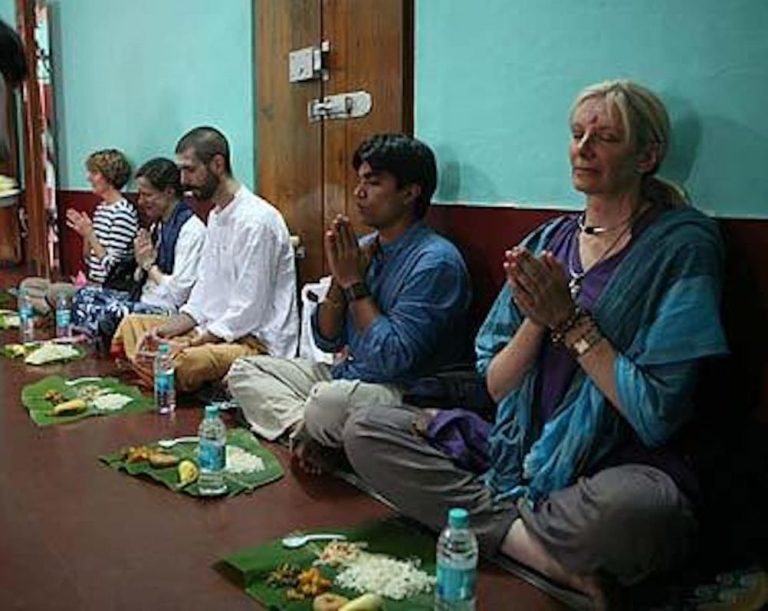Eating well is a form of self-respect – Colleen Quigley
The appetite comes during eating – Russian proverb
I used to visit my paternal village at the foot of the Western Ghats near Mysore every summer. Grandparents, one uncle and six aunts and their families, distant relatives, neighbours who came to see us – the house was filled with people at all times. And as you can imagine, feeding 30+ people for a very minimum of twice a day would have been utter chaos.
Not really.
We had a ritual for mealtimes. The plates were laid out on the floor, we filed in silently and sat down on the floor mat, the ladies of the house started serving us, and we ate mostly silently except when we needed to ask for more portions. Everybody ate the same food, irrespective of their age, health conditions or preferences. Food was served only after we sat down. The first round of serving were small portions, and the entire meal had a maximum of 2 courses – mostly rice and some sambar or rasam, followed by rice and curd. Vegetables and lentils were usually served once. Once the men and the children ate, some of them would come back to serve the ladies. The teenagers were in charge of sweeping and cleaning of the floor after every meal while the smaller children would help wash the plates. The ladies would be tasked with cleaning the kitchen and the menfolk went off to work. The same ritual was repeated at night – same food items, same process. In between, we had ragi gruel and if we were lucky and it was the right season, ripe mangoes or guavas from our aunt’s orchard to go with it.
I came across this very same ritual when I went to Sivananda ashram for the first time, 3 years ago. We ate only twice a day – at 10 AM and 6 PM. The bell rang when it was time to eat and all of us would file in silently and sit on the floor. The volunteer in charge of the dining hall that day would say a small prayer, and then they would start serving the food. All food was locally sourced and cooked just a couple of hours before eating. Vegetables were mostly grown in their own gardens. No one spoke while the food was being served and consumed. After eating, we would get up, wash our plates and cups, and then file silently out. The volunteers then began the cleaning and the tidying up of the dining room, getting it ready for the next meal. All of us at the ashram were assigned to dining room duty at least once during our stay.
Simple, yet immensely satisfying.
What’s wrong with the way we eat today?
Everything.
On an average, a typical well-to-do person eats over 70,000 meals in his lifetime (3 meals a day at an average life expectancy of 70 years) . This does not even include snacks, quick eats, snacking in front of the TV, stress or binge eating or eating just because! I am sure you are either eating as you read this, or thinking of eating your next meal or snack. You probably have planned on grabbing a quick lunch at the cafeteria downstairs or Swiggying a sandwich from the coffee shop nearby so you can chomp it down quickly and be ready for the next meeting. Or planning to catch up quickly with friends or co-workers over dinner.
Chatting, watching TV, scanning emails or Whatsapp messages, replying to phone calls, or reading a newspaper/book while we eat is standard fare for all of us. For most of us, mindful eating is an unheard of phrase. However, every time we eat without being mindful, we are losing an opportunity to connect with our inner self.
Eating Mindfully and with Grace
Enough material and research exist in the online world to show that eating with awareness and with reverence is key to staying healthy. Some of them are listed in the Sources section below. It matters not so much what we eat sometimes; it is more how we eat it. Mindful eating involves the body, the mind and the intelligence. This is how:
The body: Our senses start indicating to us that it is time to eat. And as the Russian proverb states, most of the appetite comes to us (and our digestive juices gets created) when our senses kick in before and during the process of eating – with sounds of the vessels and the plates in the kitchen, the aroma wafting into our noses, the eyes taking in the color and the variety of food on our plates, the ends of our fingers touching, mixing and taking the food to the mouth, and the taste buds eagerly awaiting the food coming towards it.
The mind: Our mind is usually a combination of memories and impressions. There is a reason why we gravitate towards certain kinds of food when we are stressed, angry, sad, happy or delighted. (for me it is ice cream every time!) In fact, we tend to eat food that gives us a feeling of comfort and pleasure, and not to remove our hunger pangs. Depending on our cultural background, childhood eating habits and social and financial position, our memories and impressions regarding food are already formed by the time we become adults. This is also the very reason why it is impossible to change our eating habits as we grow older. Unless we are told to do so by a doctor or the gym instructor, we tend to keep eating things that we love based on what our mind wants or demands, as opposed to what our body actually needs.
The intelligence: This does not involve our IQ per se. The intelligence here refers to a combination of the brain telling the senses that the stomach is full, the mind feeling satiated, and an awareness that tells the body that we have eaten enough. If this intelligence does not kick in, we can seemingly eat for ever. Case in point – when we are highly stressed or watching mind-numbing TV! The intelligence also gives us the awareness about our eating speed – we eat more elegantly or carefully when we are at a social or business occasion, and chomp down our food when we are with family or eating alone.
Tips to eating with the body, mind and intelligence in tandem
The key then is to eat mindfully. To eat with grace. To eat with reverence. According to Sadhguru, when we eat, we are showing our gratitude to the food on our plates and its willingness to become a part of our body. The Vaishnavites at the ISKCON centers do not just EAT FOOD; instead they call it HONORING THE PRASADAM. Prasadam refers to food that is untasted while cooking, and offered to the Lord first. When they honor the prasadam, they do so after saying a prayer, and observe silence while eating.
So how do we ensure we eat mindfully? At the very least, we need to understand that the practice of eating is not just a physical act, but a spiritual one too. Since we eat three times (at least!) every day, let us use this opportunity to connect with our internal world and inner self.
Here are very simple suggestions to keep in mind when you eat your next meal:
- Sit cross-legged on the floor: Again, there is enough material out there on why this yogic pose during eating, so am just giving the short version. It relaxes our spine, gets the blood moving towards the abdominal region for better digestion, and increases the secretion of the gastric juices as we move forward to take the food from our plate, and backward to put it into our mouth.
- Say a simple prayer: If what we eat is soon going to become a part of us, should we not give thanks? Say grace? At the ashram we chanted the “Brahmarpanam” mantra from the Bhagavad Gita (4:24) that affirms that I am energy, what I eat is energy, and I offer myself and what I eat to this Energy since everything is part of this Energy. A quick pause to give thanks would do fine as well, if that is what you prefer.
- Involve your senses: At the risk of inviting comments about my ability as a cook, I will reveal this secret. I tend to eat less when I eat food that I have personally cooked. That’s because I have already smelled, seen, tasted and heard it as it was being cooked. And yes, I do eat more when my cook makes it or when I eat at a restaurant or at a social occasion.
- Eat with your hands: The satisfaction of feeling the texture of the food, mashing and mixing it with different curries and masalas, taking bite-sized portions and slowly placing it into our mouth – go ahead and try it yourself. It is a very sensual and satisfying experience.
- Observe silence: As kids we were always told to observe silence because of choking hazards or of food going into the windpipe. At least that is what I thought. Turns out, just as we practice yoga in silence, eating also has to be done in silence so we do it with more awareness and purpose.
The New Year is here and am sure all of us want to lose weight, become healthy and look fit! I invite all of you to add this spiritual component to your eating, and see how it makes a difference to your life. Here’s to the lost art of eating.
Sources:
Image courtesy: www.wholesomeayurveda.com
https://isha.sadhguru.org/in/en/wisdom/article/how-to-eat-properly
https://isha.sadhguru.org/in/en/wisdom/article/mind-your-food
http://www.wholesomeayurveda.com/2017/02/11/ancient-traditional-asian-indian-yoga-science-sit-floor-eating/



